Beth Kephart's Blog, page 266
December 28, 2010
The Dark Side of Young Adult Fiction
 I'd love to know how many of you are out there following this thread of Room for Debate on the Opinion Pages of the New York Times. The question is: "Why do bestselling young adult novels seem darker in theme now than in past years? What's behind this dystopian trend, and why is there so much demand for it?"
I'd love to know how many of you are out there following this thread of Room for Debate on the Opinion Pages of the New York Times. The question is: "Why do bestselling young adult novels seem darker in theme now than in past years? What's behind this dystopian trend, and why is there so much demand for it?"The chosen debaters are Paolo Bacigalupi, Maggie Stiefvater, Jay Parini, Scott Westerfeld, Andrew Clements, Michelle Ann Abate, and Lisa Rowe Fraustino, with many others chiming in.
I rather like the tact Maggie Stiefvater takes. I value Paolo Bacigalupi's sensibilities as a writer. I have long struggled, especially since chairing the Young People's Literature jury for the National Book Awards in 2001, with the questions posited by Michelle Ann Abate.
What do you think?




Published on December 28, 2010 14:24
Building Book Buzz in Bethesda
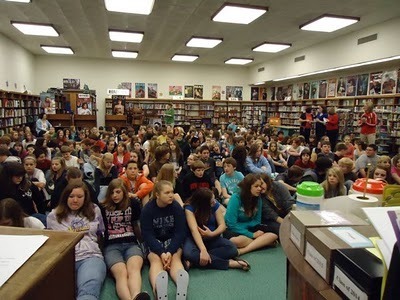 My friend Ivy has a talent for sending me things that fit just right into my life (sometimes it's a book and sometimes a cheese dish and sometimes a tool to save my aching back) and yesterday, she sent this link to a Donna St. George Washington Post story titled: "Wanted: Young readers to build book buzz."
My friend Ivy has a talent for sending me things that fit just right into my life (sometimes it's a book and sometimes a cheese dish and sometimes a tool to save my aching back) and yesterday, she sent this link to a Donna St. George Washington Post story titled: "Wanted: Young readers to build book buzz."It's a story about the teen readers who gather at the Montgomery County library in Bethesda to talk books. Not just the books already on shelves across the country, mind you, but books provided through a galley review program initiated by the Young Adult Library Services Association of the American Library Association. What the teens have to say about the books tell publishers, librarians, and writers quite a lot about what excites and what does not, and about where a book might be headed.
I loved reading the story, because I love the honesty of teens, and I love what happens when they gather within libraries. (The photo above, for example, was taken just ahead of a talk I gave in a Wisconsin school library earlier this year, and I was amazed by the buoyancy of those readers, by the questions they asked and the things they confessed to.) I love, too, how librarians and publishing houses are working together to fuel the fervency of the book-loving young.




Published on December 28, 2010 06:46
December 27, 2010
Snow drifts and sun spoils
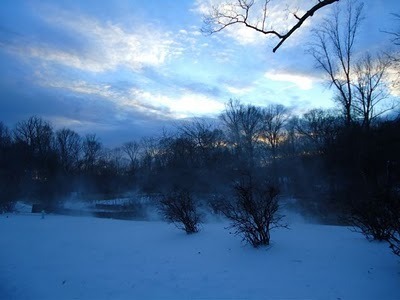

Wearing my new coat and gloves and my brand new UGGS, tucked in with a tried and true pair of jeans, I went out hunting for snow drifts and sun spoils at dusk.
I found these.




Published on December 27, 2010 14:33
Creative Nonfiction 135.302/Settling on a Syllabus
 One writes a course description months ahead of teaching the course itself, and in the meantime, one inevitably reads deeper, thinks harder, disproves former standing theories, and reassesses writers they once loved. At least that's how it is for me.
One writes a course description months ahead of teaching the course itself, and in the meantime, one inevitably reads deeper, thinks harder, disproves former standing theories, and reassesses writers they once loved. At least that's how it is for me.Yesterday and today, then, I'm studying the course description below and thinking about how I'll meld what seems pulsing and essential right now with the promises I've already made. I have an idea about a particular Joan Didion essay, and I'm going to kick things off with that. I'm going to insist on some Ander Monson and Carl Klaus to further set the stage. I'll bring some fiction in, and some poetry, too, so that I and my fifteen students might think out loud about wavering edges—about the nicks and tucks that are nonfiction and the elaborations that are not.
I never teach to deliver what I know (what fun would that be, for any of us?, and besides, who really knows what?). I teach for the conversations that erupt, for the work that might emerge, for the deep delve that is yearning and process. I teach because the possibilities are rich, and because there are no barricades within a classroom.
@font-face {
font-family: "Cambria";
}p.MsoNormal, li.MsoNormal, div.MsoNormal { margin: 0in 0in 0.0001pt; font-size: 12pt; font-family: "Times New Roman"; }div.Section1 { page: Section1; }
We'll be asking questions throughout this section of Creative Nonfiction, and we'll be writing and reading our way toward answers: What do we owe our writing, and what does it owe us? What is the role of imagination in memoir? How is the persona of our nonfiction different from the person we know ourselves to be, and how different should it be? How important is it, really, to distinguish between story and situation? We'll be provoked and inspired by the work of such authors as Patricia Hampl, Lia Purpura, Joan Didion, Julian Barnes, Natalie Goldberg, Grace Paley, William Fiennes, Michael Ondaatje, Vivian Gornick, and Terrence Des Pres. We'll workshop essays, memoirs, and profiles.




Published on December 27, 2010 07:16
December 26, 2010
Vida/Patricia Engel: Reflections
 Last night I was explaining to my brother how you don't get perfect from perfect. Glass deflects, I said. Airtight frames let no one in. You get perfect from raw and real, from quest and search, from words that feel ripped out, not placed. You get it from writing that honors bewilderment, that shapes it, even, from stories and language that make you feel. I said these things, and then I went to bed and when I woke up I read Vida, Patricia Engel's debut collection (Black Cat), from start to finish.
Last night I was explaining to my brother how you don't get perfect from perfect. Glass deflects, I said. Airtight frames let no one in. You get perfect from raw and real, from quest and search, from words that feel ripped out, not placed. You get it from writing that honors bewilderment, that shapes it, even, from stories and language that make you feel. I said these things, and then I went to bed and when I woke up I read Vida, Patricia Engel's debut collection (Black Cat), from start to finish.Exhibit A: My kind of perfect.
You're going to want to know what Engel's stories are about. I'm going to tell you to go read them. To find out what a writer born to Colombian parents and raised in New Jersey and residing now in Florida makes of a character named Sabina, who shares at least some of her author's lineage. Sabina carries these stories; mostly she tells them. She takes us into shame, confusion, unrest, dishonor, one version or another of love, and of love's betrayals. She gives us ascent and tip and instability, and in every single story, I believed I was reading the true. I believed that a woman could hurt like this, want like this, wish herself to be someone other than this. I believed a woman living this kind of life would make this kind of poetry. The point is: I believed.
And can we talk about language? Can I give you this?
Just when I've beaten the night, I feel his arm on me. Lou shaking me from my half sleep, his muscular fingers tugging my skin. The darkness breaks with the glow of the street, spots of car lights on the walls, shining right through Lou so he looks as if he has a halo. He turns on a lamp. He's got a guitar hanging from a strap on his back and another, which he hands to me. I sit up, let the quilt become a pond around my waist. Take the guitar from him and run my fingertips over the fat metal strings.That's from a story called "Refuge," the hands-down best post-9/11 piece of writing I've ever read. Because 9/11 is both backdrop and mood, but it isn't, ultimately, the story.
Patricia Engel does not need me to sing her praises. Vida is, among other things, a New York Times Notable Book of 2010, a Barnes & Noble Best Book of the Year, a New York Times Editors' Choice, and a Los Angeles Times Gift Guide Selection. It is the debut that Junot Diaz said he'd been waiting for.
Vida is alive. It trembles.




Published on December 26, 2010 06:11
December 25, 2010
The Hole We're In/Gabrielle Zevin: Reflections
 I've been wanting to read a Gabrielle Zevin novel for quite some time, and after all the festivities of Christmas were bowed out and complete, I slipped away to the brand-new couch with Zevin's newest novel for adults in hand. "Meet the Pomeroys: a church-going family of five living in a too-red house in a Texas college town," the flap copy reads. "Roger, the patriarch, has impulsively decided to go back to school, only to find his future ambitions at odds with the temptations of the present. His wife, Georgia, is trying to keep things afloat on the home front, though she's been feeding the bill drawer with unopened envelopes for months, and can never find the right moment to confront its scary, swelling contents...."
I've been wanting to read a Gabrielle Zevin novel for quite some time, and after all the festivities of Christmas were bowed out and complete, I slipped away to the brand-new couch with Zevin's newest novel for adults in hand. "Meet the Pomeroys: a church-going family of five living in a too-red house in a Texas college town," the flap copy reads. "Roger, the patriarch, has impulsively decided to go back to school, only to find his future ambitions at odds with the temptations of the present. His wife, Georgia, is trying to keep things afloat on the home front, though she's been feeding the bill drawer with unopened envelopes for months, and can never find the right moment to confront its scary, swelling contents...." Too-red house, I thought. Feeding the bill drawer with unopened envelopes. I was already keen on the sound of this book, the implied possibilities, when I opened it to its first page and read:
Midway through his son's graduation from college, somewhere between the Ns and the Os, Roger Pomeroy decided that he owed it to himself to go back to school. He was forty-two years old, though people told him at least once a week that he looked younger. Last Christmas, a salesgirl had mistaken his then nineteen-year-old daughter for his wife. Last week, a different salesgirl had mistaken his forty-one year old wife for his mother. He knew it wasn't flattery, because in both instances the salesgirls had already made their sales: respectively, a flannel nightgown (wife's Christmas) and a leather fanny pack (son's graduation).In five seemingly effortless (though of course they are hardly effortless) sentences, Zevin has set a rather immaculate stage—framed a Mr. Pretty (if he does say so himself) who daydreams through his son's college graduation, declares himself worthy of just a little self-satisfying something, and dresses his wife, at night, in flannel. We're in for a ride, we eavesdroppers on the Pomeroys. We're in for debt and guilt and shame and disaster; we're in for a portrait of our times and for killer characterizations achieved with economic zing.
Consider the way Zevin pulls back the curtain on a woman who is not the saintly Roger's wife:
Her lone suitcase was a creamy brown leather, a bit battered by glamorously so, the sort of thing a reporter carried to cover a war or a fashion show. She had a tiny spray bottle that she used to hydrate her face. "Would you like a spritz?" she asked Roger just before they were told to put away their electronic devices. He accepted and felt instantly transported to a tropical rainforest. Why didn't George have tricks like that?"All we need is the spritzer to conjure this woman. All we need is the word "transported" to anticipate her oily impact on our anti-hero. And of course Roger, so pretty, so self-indulgent, so righteous, so right, so self-forgiving, manages to riddle his entire family with pain, because when you're only paying attention to yourself, you are plain not paying attention.
There's parody here, and skewering. There are scenes that made me cringe (Zevin wanted me to cringe) and scenes that made me cry (she's good at that, too), and all the while there are reminders that Zevin is up to far more than mere entertaining here, as when she writes, knowingly, "people did what they could live with; all sin was relative."
I received The Hole We're In as a gift from Black Cat—a surprise package brought on by a tired UPS mailman in the dark of Tuesday night. I'm about ready to settle in with Patricia Engel's Vida now. Let the snow fall where it will; I'm reading.




Published on December 25, 2010 14:55
In search of lights on Christmas Eve
 Following the Christmas Eve pageant, we drove, looking for lights. Blue lights in tall trees, wreathed lights in windows, two stars drawn out on a slanting lawn, a blow-up Frosty, paired sets of twinkles.
Following the Christmas Eve pageant, we drove, looking for lights. Blue lights in tall trees, wreathed lights in windows, two stars drawn out on a slanting lawn, a blow-up Frosty, paired sets of twinkles.But it was this, caught just before dusk, that said Christmas to me. I had been rushing and working.
I stopped.
Merry Christmas to you all today.




Published on December 25, 2010 04:37
December 24, 2010
Two sons and their mother on Christmas Eve
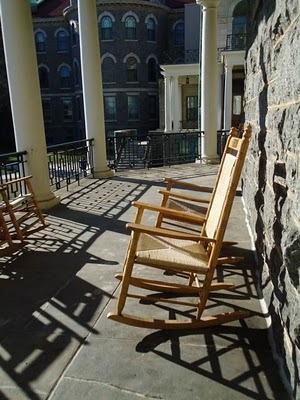 And so it happened that we were driving down one road that led to another that wound past a sign that announced the college my Salvadoran mother-in-law attended years and years ago.
And so it happened that we were driving down one road that led to another that wound past a sign that announced the college my Salvadoran mother-in-law attended years and years ago."We have to go see it," we said, at once, and so there we were, my husband, brother-in-law (visiting from Texas), and yours truly, walking through the lovely campus on a brisk day. We were the only ones there, but somehow Nora was there, too—giggling with her girlfriends, running through the halls, begging for forgiveness. I listened to the stories the brothers conjured and told. I listened to them laughing. I'm not sure it matters if any of their stories were true. It only matters that two sons—one transplanted to Philadelphia, one transplanted to Dallas—were spending Christmas Eve day with their mom.




Published on December 24, 2010 10:05
Farmer's Market, 6 a.m., Christmas Eve
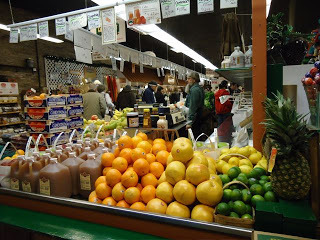

 It isn't Christmas unless you join the dawn throngs at the local Farmer's Market, where Andrew, the young man from the vegetable stand, puts your winesaps into a briskly snapped-open bag (while reporting on college), and the lady at the bread stands makes her most honest recommendations (Italian, she suggests, not French), and the purveyors of fish go into the back to retrieve the best of the long black mussels. I arrived in the dark this morning. When I opened the doors, the night sky was a brilliant purple pink, a color that would not allow itself to be photographed.
It isn't Christmas unless you join the dawn throngs at the local Farmer's Market, where Andrew, the young man from the vegetable stand, puts your winesaps into a briskly snapped-open bag (while reporting on college), and the lady at the bread stands makes her most honest recommendations (Italian, she suggests, not French), and the purveyors of fish go into the back to retrieve the best of the long black mussels. I arrived in the dark this morning. When I opened the doors, the night sky was a brilliant purple pink, a color that would not allow itself to be photographed.You just had to be there.




Published on December 24, 2010 04:56
December 23, 2010
Scenes from this day
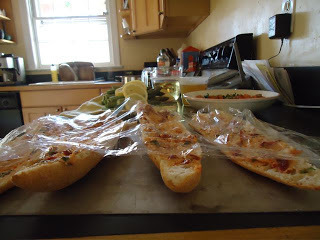
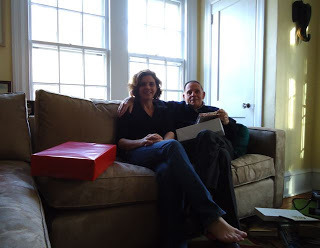 Sometimes it takes a day to create a moment. We had, to begin with, an array of fabulous cheeses and fruits, moved on to homemade butternut squash soup and bruschetta, took a risk with saltimbocca (the risk paid off), asparagus, and fingerling potatoes, and finished with an Amish baker's cheesecake (I have no cheesecake making abilities). By four o'clock, we were done.
Sometimes it takes a day to create a moment. We had, to begin with, an array of fabulous cheeses and fruits, moved on to homemade butternut squash soup and bruschetta, took a risk with saltimbocca (the risk paid off), asparagus, and fingerling potatoes, and finished with an Amish baker's cheesecake (I have no cheesecake making abilities). By four o'clock, we were done. Tomorrow: paella.




Published on December 23, 2010 14:34



